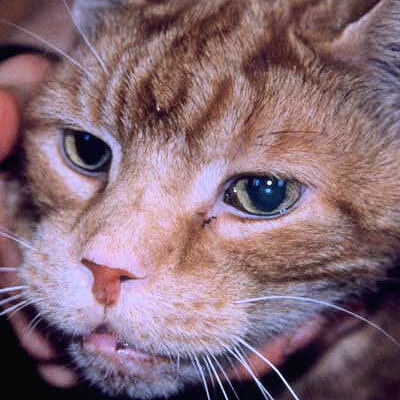Acromegaly is a relatively rare condition, caused by excessive hormone production in the brain or in mammary gland (breast) tissue. It is more common in cats than dogs. Affected cats can develop gradual changes in their appearance but because the disease develops over a long period of time owners may not notice any problems. Some cats become extremely hungry or start drinking and needing to use the litter tray more frequently. Often it is the vet who notices the change in a cat’s appearance, when cats are presented because of the changes in appetite or increased drinking and may recommend further investigation. It is important to get a diagnosis as early as possible if treatment is to be effective.

Acromegaly is caused by the production of too much ‘growth hormone’, which, as its name suggests, stimulates body tissues to grow. If too much growth hormone is produced it causes many tissues in the body to grow bigger, causing problems for the cat. Growth hormone also interferes with the way insulin works and so cats with acromegaly often have diabetes that may be very difficult to control and they may need a higher dose of insulin than expected in ‘normal’ diabetic cats.
Growth hormone is made in a specialised part of the brain (the pituitary gland). The amount of growth hormone in the body is normally carefully controlled. When there is enough growth hormone, signals are released that tell the pituitary gland to stop producing any more. Acromegaly is usually caused by a small cancer in the pituitary gland that continues to produce growth hormone despite the signals telling it to stop.
Acromegaly usually affects middle-aged or older cats (8-14 years) and males more often than females. The physical signs of acromegaly can be difficult to see and the changes come on very slowly, so an owner, seeing their cat every day, may not notice alterations in its appearance. Sometimes you can only see how much your cat has changed by looking back at photos of your cat taken some years ago. Acromegaly often causes widening of the face – which is sometimes easiest to appreciate by looking at the teeth (which move apart as the bone grows, widening the space in between the teeth).
In many cases owners first notice there is something wrong with their cat when it develops the signs of diabetes (excessive drinking and urination and increased appetite). Your vet may first diagnose your cat as having simple diabetes and prescribe insulin injections. If, after a period of time, your cat does not seem to be responding as expected to the injections your vet will want to do further tests. If it is discovered that your cat is resistant to the effects of insulin then a diagnosis of acromegaly may be suspected.
Your own vet may make the diagnosis of acromegaly or they might refer your cat to see a specialist for investigation of one of the problems caused by acromegaly.
Your cat’s appearance may make a vet suspicious of acromegaly. It is likely that your cat may already have been diagnosed as having diabetes, but if not blood tests may show abnormally high levels of sugar (glucose) in the blood and sugar in the urine. Serial blood tests may also show that your cat is not responding to insulin injections as well as expected.
X-rays and ultrasound may show that your cat has an enlarged heart (or, if changes have been present for a long time, even heart failure), or changes to the kidneys bones and joints. Blood tests can measure the levels of hormones in the blood but these often have to be sent to specialist laboratories and it can take some time to get a result back.
A scan of the brain (CAT scan or MRI) can be used to try to visualise the growth in the pituitary gland, and this scan will be necessary if you are considering having treatment for your cat.
Removal of the cancer in the brain is difficult – it would be unusual in the UK for surgery to be performed. Some centres can use radiotherapy to direct a beam of radiation into the cancerous growth in the brain. In cats, so far, no obvious side effects have been noted and the treatment seems to be tolerated extremely well.
Radiotherapy can only be performed at specialist centres and requires a general anaesthetic. If you decide to have this treatment you would have to take your cat along to the centre for a number of treatments over several weeks (or your cat may be able to board in the hospital for the duration of treatment).
Drugs that inhibit growth hormone production can be given as tablets – unfortunately these are not usually very effective.
If the cancer can be destroyed then the high level of hormones will drop and the signs of acromegaly hopefully resolve slowly. However some organs may have already been too damaged at the time of diagnosis to recover fully, and some changes may persist even after treatment. Often insulin requirements will go down a lot in diabetic cats, but your cat may still require insulin injections daily. In a significant number of cats the diabetes resolves completely or the signs relating to the growth in the brain improve due to the shrinkage of the growth.
If the disease is not treated more serious problems like kidney disease, high blood pressure, permanent diabetes, joint problems, seizures and heart problems can develop. On average cats with acromegaly live around 18 months from diagnosis if they receive no treatment. They will almost certainly suffer from diabetes and this may be very difficult to control with insulin injections. However it is important to persevere with insulin treatment as without this the signs of diabetes would be even more severe. Most cats eventually die as a result of other complications of the disease such as heart or kidney failure.
